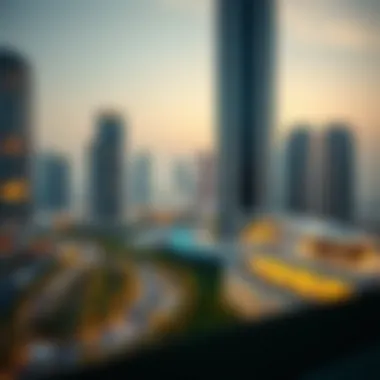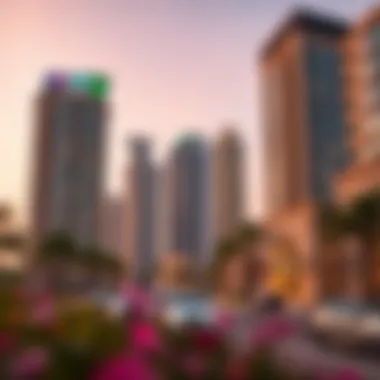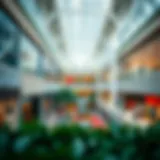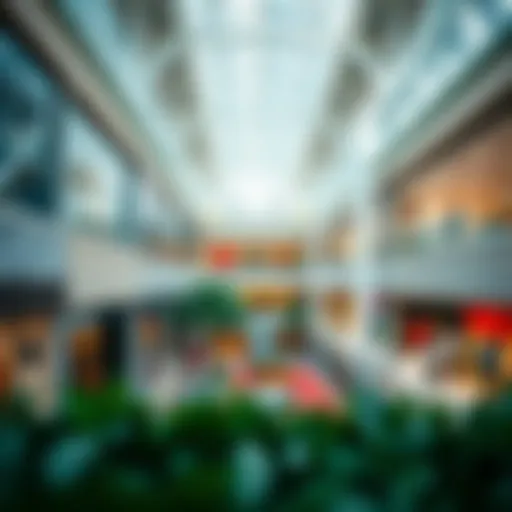Gulf Land Developers: Shaping Dubai's Real Estate Future


Intro
Dubai's real estate market is a thriving ecosystem, constantly evolving to meet the demands of a diverse and dynamic population. At the heart of this transformation are Gulf land developers, pivotal players who not only construct buildings but also shape the very fabric of urban life. Understanding their role provides valuable insights for investors, buyers, and sellers alike.
This article will take you on a journey through the intricate landscape of Dubai's real estate sector, focusing on the impact of Gulf land developers on urban growth and investment opportunities. We'll delve into current market trends, investigate key factors influencing property prices, and identify the best areas for property investment. Additionally, we'll tackle the legal considerations for foreign investors, ensuring you are well-equipped with the knowledge to navigate this ever-changing landscape.
In this ongoing narrative, we'll explore both the opportunities and challenges that come with investing in this market, aiming to illuminate the path forward for those eager to take part in Dubai's spectacular growth story.
Prologue to Gulf Land Developers
The Gulf Land Developers play a crucial role in the vibrant real estate market of Dubai. This segment of the economy not only determines urban growth but also becomes a vital component for both local and foreign investors. By analyzing Gulf Land Developers, we uncover not just the structures rising from the desert sands, but also the socio-economic impacts that resonate throughout the region.
Understanding the Market Dynamics
The dynamics of the Dubai real estate market are as multifaceted as a well-crafted mosaic. To appreciate the depth of development in this city, one must realize the interplay between supply and demand, investor confidence, and the regulatory environment. The real estate sector operates within a framework where local regulations, global financial trends, and cultural factors coexist.
Investors often seek properties that offer more than just a roof over their heads; they look for value appreciation, rental income, or a sound investment strategy. Throughout the years, Dubai has undergone several transformation phases. Property prices skyrocket during boom periods, while corrections often follow, showcasing the necessity for investors to stay informed.
Moreover, key factors like changing demographics, increased tourism, and government initiatives designed to bolster economic growth further shape the market dynamics. By understanding these elements, prospective investors can make sound decisions, tailoring their investments to align with current market behaviors and projections for future growth.
Historical Context of Development in Dubai
Dubai's transformation from a small fishing village to an urban marvel is a story worth telling. The historical context of property development in the region paints a picture of ambition and visionary planning. In the late 20th century, Dubai's rulers realized the potential of tourism as a revenue stream. As global attention turned towards this tiny emirate, groundbreaking projects emerged.
The construction of the Burj Khalifa marked a turning point, symbolizing not just architectural brilliance but also an economic strategy aimed at positioning Dubai on the world map. Regulations tailored to attract foreign investment, such as the introduction of freehold property in 2002, have fueled demand. This opens the door for foreign investors to partake in the once exclusive market controlled by citizens.
The rapid evolution of Dubai into a cosmopolitan hub has been further characterized by an ongoing quest for modernization and luxury. As time moves on, we'll continue to witness the influence of global trends on local developers, bringing an ever-changing yet rich narrative to the Dubai real estate landscape.
"Dubai's journey from desert to a global architectural icon is a testament to its resilience and forward-thinking mindset."
In summary, an understanding of Gulf Land Developers is essential not only for investors but for anyone interested in the noteworthy transformations unfolding in the Dubai real estate scene.
Key Players in the Gulf Development Scene
The real estate landscape in Dubai is shaped distinctly by a handful of influential movers and shakers. Understanding the key players in this sector is a vital cog in the wheel for anyone eyeing investments or interested in the dynamics of property development. These players range from large corporations to innovative boutique developers, each contributing uniquely to the market.
Major Development Companies
At the heart of Dubai's rapid transformation are the major development companies. These firms have established a reputation for pushing the boundaries of architecture and urban design. Notably, Emaar Properties stands tall with its flagship project, the Burj Khalifa, which isn't just a building; it's a symbol of ambition. On the other hand, DAMAC Properties has made a name with luxurious properties tailored for a high-end clientele. Their approach often combines lavish living with bespoke services, attracting both local and international investors.
Furthermore, consider Nakheel, which is synonymous with grand projects like the Palm Jumeirah. This company has capitalized on the unique waterfront views that Dubai offers, creating not just homes but entire communities. Investors are drawn to these developments because they are markers of stability and prestige in an ever-evolving market.
Innovative Boutique Developers
While the major players dominate the skyline, innovative boutique developers are carving out their niche by focusing on thematic and unique design principles. Firms like Grove Developments and Meraas are offering bespoke projects that cater to specific audiences, such as young professionals or luxury seekers who crave a distinctive living experience. These smaller developers often employ agile methodologies, adapting quickly to emerging trends and buyer desires.
With an emphasis on sustainability, many boutique developers are tapping into eco-friendly materials and energy-efficient designs. Investing in such projects can yield high returns, as there's a growing demand for properties that align with environmentally conscious buyers' values.
Government Initiatives and Their Role
The significance of government initiatives in shaping the real estate landscape cannot be overstated. The Dubai Land Department plays a pivotal role by implementing policies that facilitate foreign investments and streamline the ownership process. Recent initiatives have been geared toward attracting international investors, which is critical for a market that thrives on foreign capital.
For example, the introduction of long-term residency visas for investors has been a game changer. This has not only heightened the interest from overseas buyers but also encouraged them to consider Dubai as a long-term investment destination rather than a short-term speculation ground. The government's foresight in branding Dubai as a global city has elevated the profile of local developers, allowing them to flourish amidst global competitors.
"The collaboration between private developers and government policies sets the stage for not only economic growth but also community development, addressing the needs of residents and investors alike."
In summary, comprehending the players at the helm of Gulf development offers invaluable insights into market trends and investment opportunities. The interplay of established companies, innovative developers, and supportive government actions create a multifaceted environment that both investors and buyers must navigate judiciously.
Trends Shaping the Future of Dubai's Real Estate
The realm of Dubai's real estate is continually evolving, influenced by a myriad of factors that collectively shape its future landscape. Recognizing the significance of current trends is crucial for investors, real estate agents, buyers, and sellers alike. These trends are not just passing fads; they illustrate the changing dynamics of the market, reflect community demands, and provide insight into future opportunities.
Understanding trends is vital for stakeholders to make informed decisions, develop sustainable practices, and harness technologies that enhance property offerings in ways that appeal to new generations of buyers and renters. The conversation surrounding these trends encompasses a range of elements, including environmental sustainability, technological advancements, and mixed-use developments that prioritize both functionality and lifestyle.
Sustainability and Eco-Friendly Projects
In recent years, sustainability has firmly planted itself at the forefront of many development projects in Dubai. Residents and investors alike are increasingly aware of the environmental impacts of construction and urban living. This awareness drives the demand for eco-friendly materials and energy-efficient designs.


Gulf land developers are responding to this shift by embracing practices that reduce carbon footprints—think solar panels, green roofs, and the use of recycled materials in construction. These initiatives not only cater to environmentally conscious consumers but also align with Dubai's vision of becoming one of the smartest and most sustainable cities in the world. For instance, Dubai's Clean Energy Strategy 2050 aims for a significant portion of energy consumption to be derived from clean sources, setting a benchmark for developers to follow.
"Sustainability isn’t just an option anymore; it’s a necessity in the modern real estate landscape."
Moreover, the integration of green spaces in residential communities fosters a healthier lifestyle, blending leisure and ecological responsibility. Developing these eco-friendly projects may require larger initial investments, but the long-term return on investment often outweighs those costs, making them a worthwhile endeavor.
Smart Technologies in Property Development
As the world becomes more intertwined with technology, so too does the real estate market. Smart home technology is revolutionizing property development, ensuring that new constructions in Dubai are not just modern but also equipped for the demands of a tech-savvy population. Features such as automated lighting, smart thermoregulation, and integrated security systems enhance the living experience while also reducing operational costs for property owners.
The introduction of Building Information Modeling (BIM) during the development phase allows contractors and architects to visualize the project more accurately, optimizing the entire construction process. Additionally, data analytics is becoming increasingly valuable for developers to forecast market trends and consumer preferences, enabling them to tailor properties to meet future demands effectively.
As the landscape shifts towards digitization, smart workplaces that promote connectivity will emerge, playing an integral role in redefining commercial spaces moving forward.
Mixed-Use Developments: A New Wave
A shift is taking shape in Dubai's urban fabric with the rise of mixed-use developments. These projects combine residential, commercial, and recreational spaces into cohesive environments that cater to diverse needs. This trend is all about creating neighborhoods that promote a sense of community, allowing residents to live, work, and socialize without needing to travel far.
Such developments reflect the growing preference for convenience and accessibility, particularly among younger generations who seek vibrant living areas that offer more than just a place to stay. Design components often include parks, retail outlets, cafes, and community centers, fostering social interaction.
The benefits extend not just to residents but also to investors; these projects attract a wider tenant pool due to their multifunctionality, potentially leading to higher occupancy rates and increased rental yields.
In summary, keeping a finger on the pulse of these trends can empower stakeholders in Dubai’s real estate market. Sustainability, smart technologies, and mixed-use developments are not standalone elements—they weave together to create a robust, dynamic future for property development in the region. With adaptive strategies, Gulf land developers can ensure their projects resonate with both local communities and the global market.
Investment Opportunities in Gulf Developments
Investment in Gulf developments, particularly in Dubai, has been an ever-evolving landscape, attracting both local and foreign investors alike. The appeal lies not just in the stunning architecture and luxurious living conditions, but also in the unique economics that underpin this vibrant market. The variety of investment opportunities can lead to substantial financial returns if approached with the right insights and understanding.
Residential Projects
When it comes to residential investments, the market offers a vast array of options ranging from high-end luxury villas in areas like Palm Jumeirah to more affordable housing in developing neighborhoods. There are a couple of key elements to consider here:
- Location, Location, Location: Properties in prime areas like Downtown Dubai or Dubai Marina often hold their value exceptionally well, making them attractive for long-term investment. Investing here may mean substantial capital appreciation down the line.
- Diverse Architecture: The architectural styles vary significantly, attracting different kinds of buyers. For example, contemporary designs appeal to young professionals, whereas traditional styles attract families.
Investors must also assess the local demand for real estate, as fluctuations can significantly affect rental yields. Investors who can read the pulse of market trends may find lucrative opportunities, especially with the upcoming projects linked to Expo 2020.
Commercial Real Estate Potential
The commercial real estate sector in Dubai is often regarded as a powerhouse for attracting international businesses. With sectors like hospitality booming and retail spaces expanding, investors have several promising avenues to explore:
- Vibrant Market: The rise of e-commerce and retail, alongside a recovery in tourism post-pandemic, means commercial spaces are in demand. Investors can benefit from leasing opportunities across malls, office spaces, and co-working environments.
- Business Friendly Environment: The government’s efforts to enhance ease of doing business in Dubai have made it a magnet for companies looking to establish a foothold in the Middle East. This translates to a more stable demand for commercial properties.
Getting into commercial real estate not only diversifies an investment portfolio but can yield higher rental yields, appealing to those ready to navigate this competitive market landscape.
Financial Considerations for Investors
When considering investments in Gulf developments, it's crucial to factor in the financial landscape. This includes understanding the total cost of ownership, financing options, and potential returns:
- Financing Choices: Various banks and financial institutions offer tailored loan solutions for property purchases in Dubai. Investors should perform due diligence to select the best financing route that fits their needs.
- Cost vs. ROI: Evaluating the cost of purchase against projected rental income and capital appreciation is vital. Many experts suggest a 10-12% annual return on investments in Dubai's residential sector as a benchmark.
- Hidden Costs: Foreign investors must also keep an eye on additional costs such as maintenance fees, service charges, and potential property taxes, which could chip away at profit margins if not accounted for.
"Navigating the financial terrain of Gulf developments requires a keen understanding of market dynamics and financial acumen to maximize returns."
Navigating Regulatory Frameworks
When it comes to the real estate terrain in Dubai, regulatory frameworks have a significance that can't be brushed off. For Gulf land developers looking to make their mark, understanding the myriad regulatory elements is essential. This not only aids in compliance but also shapes their strategies, ensuring long-term success in this vibrant market. Various rules and regulations dictate everything from property ownership to construction practices, making it prudent for developers to navigate these waters with care.
Understanding Ownership Laws
Ownership laws in Dubai are a maze, yet comprehending them is like holding a map to hidden treasure. The laws can differ significantly depending on whether the property is located in a freehold area or a leasehold area. Somewhere like Dubai Marina allows for freehold ownership for expatriates, meaning they can fully own their property. On the other hand, leasehold areas require foreign investors to lease land for a duration, often up to 99 years.
Certain laws also regulate how many units a non-national can own in a particular project. It's not a simple one-size-fits-all situation. For example, understanding whether your purchase aligns with the plans laid out by the Dubai Land Department can make or break an investment.
"Understanding ownership laws can save time, money, and even heartache down the line."
Permitting and Approval Processes
When it comes to developing land, not having the proper permits is akin to building a house of cards. The permitting process in Dubai demands diligence and understanding. Developers usually need to engage with multiple governmental bodies, including the Dubai Municipality and the Dubai Lands Department, to secure the numerous approvals required for any construction project.
These permits cover a broad spectrum of criteria, from safety and environmental assessments to ensuring compliance with urban planning regulations. Failure to adhere to these processes not only delays projects but could also lead to hefty fines or the dreaded halt of a project entirely. Therefore, knowing the right channels and the right people can simplify navigating this bureaucratic labyrinth.


Impact of Local Governance on Developers
The role of local governance in shaping Dubai's real estate market is significant. Local governing bodies can influence everything unfolding from tax incentives to zoning restrictions. Understanding these local nuances can provide developers with strategic advantages.
In recent years, Dubai has seen shifts in local governance aimed at stimulating further foreign investment. Initiatives to streamline processes, reduce bureaucratic red tape, or even introduce tax exemptions can be critical boosters for development projects. An informed developer can leverage these elements to enhance their project's feasibility.
- Governance Structures: Familiarizing oneself with local councils and their mandates can be advantageous, as these entities can be both gatekeepers and facilitators.
- Engagement with Authorities: Regular interactions with local governance can pave the way for collaborations that benefit both developers and the community, thus presenting a win-win scenario.
Navigating these frameworks is no small feat, but for Gulf land developers, mastering this landscape can open up a world of opportunities.
Community Development and Its Implications
Community development plays a crucial role in shaping Dubai's urban landscape and the effectiveness of Gulf land developers. In a city that has transformed from a humble fishing village into a global powerhouse, the need to align urban growth with community needs has never been more pressing. As developers embark on ambitious projects, they must navigate a complex environment where the aspirations of residents and the demands of the market intersect. This balancing act significantly impacts social cohesion, economic viability, and the overall livability of the city.
Balancing Urban Growth and Community Needs
Navigating the intricacies of urban growth while addressing community needs is a challenge faced by many developers. The rapid expansion of Dubai has brought forth a myriad of opportunities, but it also invites criticisms regarding sustainability and community welfare. Developers must consider not just the construction of high-rise buildings, but also how these developments can improve the quality of life for residents.
For instance, the Dubai Creek Harbour project seeks to integrate residential and commercial spaces with ample green areas, aiming to foster community ties. Such efforts involve engaging with local stakeholders, gathering feedback, and understanding the specific needs of various demographic groups. It’s not merely about building structures; it’s about constructing a sense of belonging.
“The success of any neighborhood lies in its ability to adapt and cater to the community it serves.”
Integrating Amenities and Services
A well-planned community development must prioritize the integration of amenities and services that cater to the public. Access to schools, healthcare, recreational facilities, and shopping areas are vital components that can elevate a development from being a mere collection of buildings to a community hub. Take Dubai Marina, for example; its success can be attributed to its clumping of services and amenities within walking distance, promoting a lifestyle that’s both convenient and family-friendly.
- Accessibility: Developers should ensure that all essential services are within easy reach.
- Public Transport: Efficient public transportation links can enhance connectivity and reduce traffic congestion.
- Community Centers: Spaces for social interaction can help forge connections among residents.
These elements foster a vibrant atmosphere where residents feel comfortable and engaged, rather than isolated in their living spaces. Integrating them into the initial phases of development is crucial for ensuring long-term satisfaction.
Cultural Considerations in Development
Developers must also be cognizant of the rich cultural tapestry that defines Dubai. With its diverse population, cultural sensitivity becomes a paramount consideration in development projects. For instance, including spaces for cultural institutions can serve as bridges between different communities and enhance social inclusiveness.
- Architectural Style: Projects can reflect local traditions while incorporating modern designs that appeal to expatriates.
- Cultural Events: Designated areas for festivals and community gatherings promote cultural exchange and social harmony.
- Language Accessibility: Including multiple languages in signs and materials can accommodate the city's diverse inhabitants.
Cultural considerations are not merely about respecting heritage; they are about fostering a sense of identity that resonates with all stakeholders.
Promoting community development that balances growth with local needs is a challenging yet rewarding endeavor for Gulf land developers. As they embark on this journey, the implications of their choices will reverberate throughout Dubai for generations to come.
Case Studies of Notable Projects
Exploring case studies of notable projects is essential to understand the dynamics of Gulf Land Developers. These examples serve not only as a testament to innovation but also highlight the lessons learned from successes and failures alike. Investors, buyers, and even other developers can glean invaluable insights into effective strategies, market demands, and the impacts on local communities. By dissecting individual projects, one can appreciate the broader trends and subtleties of the Dubai real estate market.
Iconic Residential Developments
Iconic residential developments in Dubai stand as keystones in its architectural skyline. Projects like the Burj Khalifa Residences and The Palm Jumeirah Villas have not only redefined luxury living but also symbolize bold visions translated into reality. These developments fulfill essential needs while boosting the city's reputation as a global destination.
- Visual Appeal and Innovation: Each project boasts unique architectural styles that marry functionality and visual charm. For instance, The Address Boulevard combines contemporary designs with high-end amenities, making it an attractive choice for discerning buyers.
- Market Response and Value: The success of these residential projects often hinges on their ability to respond to the shifting demands of the housing market. Investors can learn that catering to a diverse audience—from families to single professionals—can yield higher occupancy rates and ensure investments are sound in fluctuating economies.
- Community Impact: Luxury developments also shape their surroundings. For example, the waterfront properties on The Palm not only enhance real estate values but promote community engagement through recreational spaces, parks, and entertainment venues.
Transformative Commercial Spaces
Transformative commercial spaces illustrate how Gulf Land Developers can alter the economic fabric of Dubai. Projects such as Emaar Square and Dubai Design District (d3) encapsulate the shift towards modernization, responding to the growing demand for creative industries and business hubs.
- Adaptive Strategies: Successful commercial properties adapt to changing business models. Dubai Design District, for example, has created a vibrant environment for the fashion and design sectors, attracting local and international talent. Its impact extends beyond just leasing properties; it creates a community of innovators.
- Economic Catalyst: Such developments don’t just benefit their owners. They can spur economic growth by attracting a range of businesses and generating employment. The ripple effects from these commercial developments often fuel other areas of the economy, making them worthwhile investments.
- Technological Integration: Commercial spaces are increasingly incorporating smart technologies that enhance user experience. Smart buildings equipped with IoT technology improve energy efficiency, reduce costs, and provide adaptable spaces for businesses, drawing tenants who value sustainability.
“Gulf Land Developers are not just constructing buildings; they are creating ecosystems conducive to growth.”
By analyzing these case studies, stakeholders gain a clearer picture of how high-stakes investments can successfully navigate the Dubai landscape. The distinct characteristics of both residential and commercial developments emphasize the interconnected nature of real estate dynamics while providing actionable insights for future ventures.
Challenges Facing Gulf Developers
Developing properties in Dubai isn't just about mixing concrete and glass; it involves a complex maze filled with challenges that Gulf developers must navigate to stay afloat. This section highlights the hurdles they face, emphasizing why understanding these issues is vital for investors, agents, buyers, sellers, and advisors alike. Each challenge brings unique considerations and repercussions that could significantly affect development projects and overall market health.
Market Fluctuations and Economic Pressures
Dubai's property market is like a roller coaster—sometimes it's up, other times it's down. For Gulf developers, these fluctuations often create uncertainty that can stall projects or inflate costs. In recent years, shifts in global economic conditions, along with local factors like supply and demand balances, have had a profound impact. The volatility can deter investors as they become wary of potential downturns.


Factors Influencing Market Fluctuations
- Global Economic Trends: Events such as oil price fluctuations can heavily influence Dubai's economy and, subsequently, its real estate market.
- Local Supply: An oversupply of properties might reduce prices, challenging new developments to achieve expected returns.
- Regulatory Changes: Adjustments in laws and policies can also impact property values and developer strategies.
Understanding these dynamics is crucial for Gulf developers who wish to navigate the stormy seas of real estate effectively.
Construction and Labor-related Issues
Building properties in a bustling metropolis like Dubai comes with its own set of stumbling blocks, particularly concerning labor and construction management. Projects can face delays due to labor shortages, permitting issues, or regulatory compliance obstacles. For instance, the reliance on foreign labor in Dubai often leads to fluctuations based on geopolitical factors, labor laws, and prevailing economic conditions.
Key Considerations
- Labor Supply Chains: Changing political scenarios or local labor laws can constrict access to skilled workers.
- Rising Costs: Materials and labor costs have been climbing, diminishing profit margins if not managed properly.
- Compliance: Developers must constantly align their projects with governmental regulations, failing which could result in project halts.
Maintaining Quality Amidst Competition
In a thriving market like Dubai, competition is stiff. Gulf developers face the challenge of maintaining high-quality standards while also keeping costs in check. This balancing act becomes increasingly complex as new entrants and innovative ideas flood the market.
Essential Strategies
- Investing in Quality Materials: Using top-notch materials may seem like an extra cost, but it pays off in the long run through reduced maintenance and enhanced property value.
- Skilled Labor: Retaining and training skilled workers can help ensure that quality remains a priority amid cost-cutting pressures.
- Brand Reputation: Building a strong brand that is synonymous with quality can be a significant competitive advantage.
It’s clear that to remain competitive in the bustling Dubai market, Gulf developers must continuously adapt their approaches, addressing the market's volatile nature while ensuring quality and compliance without compromising on vision. This resilience is crucial for sustaining growth, enriching community offerings, and ultimately, realizing profitable outcomes.
Future Outlook and Predictions
Understanding the future landscape of Gulf land development is crucial for all stakeholders in the Dubai real estate sector. With Dubai continuing to evolve, the predictions and trends that emerge can provide not just insights, but strategic advantages for potential investors and developers. In this section, we delve into the key elements shaping future developments and uncover benefits as well as considerations that will drive decisions in this dynamic market.
Evolving Trends in Gulf Development
The pulse of Dubai’s development scene resonates with several evolving trends that are hard to ignore. One key trend is the shift towards sustainability. Developers are increasingly recognizing the necessity of eco-friendly projects, driven by both regulatory pressure and consumer preference. The integration of green building standards and renewable energy sources into new developments is becoming more than just a trend; it’s a requirement. Notably, this is evident in projects that aim for LEED certification or similar environmental credentials.
Additionally, the rise of smart technology is revolutionizing how properties are conceived and built. From smart home systems that increase energy efficiency to blockchain technologies streamlining transaction processes, technology is crafting a new paradigm. This evolution is expected to foster a more tech-savvy demographic of buyers who prefer to live in and invest in spaces that prioritize innovation.
Another noteworthy trend is the shift towards mixed-use developments. These projects combine residential, commercial, and leisure facilities into one integrated space, catering to an increasingly urban population. People are looking for versatility and convenience, and developers who can deliver this through well-planned mixed-use projects may find a ready market.
Key Features of Evolving Trends
- Sustainability Initiatives: Focus on eco-friendly materials and sustainable energy.
- Integration of Smart Technology: From property management to home automation.
- Mixed-Use Developments: Versatile spaces that cater to various needs.
Implications for Foreign Investors
For foreign investors, understanding the implications of these evolving trends is paramount. The shift toward sustainable and smart development translates into a market that demands an increasingly savvy investment approach. Investors must adapt their strategies to align with these emerging requirements; those who do not may find themselves outpaced.
The landscape is also shifting in terms of regulatory considerations. Dubai’s authorities are encouraging foreign investment through various initiatives, but new regulations around sustainability mean that investors need to conduct thorough due diligence before diving in. Comprehending the legal landscape and potential changes will be vital in mitigating risks.
Moreover, foreign investors can also benefit from government incentives aimed at attracting capital towards such innovative projects. These incentives can range from reduced taxes to fast-tracked approvals for sustainable developments.
The future of Dubai’s real estate market leans heavily on adaptability. Investors who can align their strategies with emerging trends will position themselves favorably.
Takeaways for Investors
- Be Proactive: Stay informed on regulatory changes and emerging technologies.
- Consider Long-Term Goals: Invest in developments that are sustainable and smart to meet future demands.
- Leverage Incentives: Take advantage of government policies designed to boost foreign investment in innovative projects.
In summary, the future outlook for Gulf developers and investors alike is characterized by a transition towards sustainability, technological advancements, and changing residential needs. The key will be to remain flexible and informed about these driving forces to secure a competitive edge in this continually evolving landscape.
Ending: The Road Ahead for Gulf Land Developers
As the dust settles from the tremendous growth witnessed in Dubai's real estate sector, the future for Gulf land developers looks richly nuanced. The interplay of rapid urbanization, economic adaptation, and evolving buyer expectations demands a fine balance. Recognizing these dynamics is crucial for stakeholders aiming to capitalize on potential opportunities while remaining aware of lingering challenges.
Key Aspects to Consider
- Innovation at the Forefront
The integration of smart technologies and sustainable practices is no longer a luxury but a necessity. Developers must focus on innovations like energy-efficient systems and digitally connected environments to attract a discerning clientele who prioritize sustainability and technological integration. - Regulatory Adaptations
Navigating ownership laws and permitting processes requires not only savvy but also an understanding of how local governance can influence project outcomes. Stakeholders should stay updated on shifting regulations to ensure compliance and to seize potential incentives from government initiatives aimed at stimulating growth. - Community Engagement
Increasingly, developers are recognizing that community needs extend beyond mere housing. Incorporating local cultural nuances and providing meaningful amenities can enhance the appeal of developments, leading to long-term success. Engaging with residents to understand their desires fosters goodwill and strengthens community ties, ultimately enhancing property value. - Market Resilience
Economic fluctuations are part and parcel of real estate investment. Developers ought to adopt adaptive strategies to maintain resilience amidst changing market conditions. Keeping a close eye on economic indicators can help in making informed decisions about project launches and expansions.
The Value of Collaboration
Success in the Dubai real estate landscape depends heavily on collaboration among various stakeholders, including government entities, private investors, and the community. Encouraging a symbiotic relationship can lead to innovations that enhance the overall urban fabric, fostering not just profit but progress.
Final Thoughts
In navigating the complex real estate tapestry of Dubai, Gulf land developers have a unique opportunity. By focusing on innovative practices, maintaining regulatory awareness, engaging communities, and building resilient strategies, the road ahead can be transformative. With these pillars in place, developers not only contribute to the skyline of Dubai but also enhance the quality of life for its residents.
"The future of Gulf land development is paved with opportunity, but only through a nuanced approach can developers truly thrive in this vibrant market."
While the future holds uncertain waters, with strategic foresight, adaptability, and an unwavering commitment to stakeholder value, Gulf land developers can continue to shape the real estate landscape of Dubai in innovative and sustainable ways.















